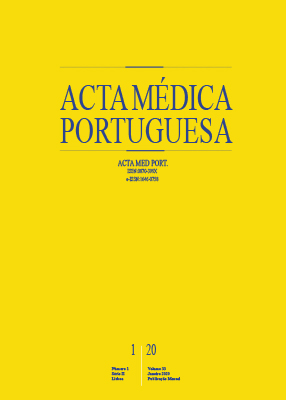Performance of Intergrowth 21st Growth Charts in the Diagnosis of Small and Large for Gestational Age in Term and Preterm Newborns
DOI:
https://doi.org/10.20344/amp.10990Keywords:
Anthropometry, Birth Weight, Gestational Age, Growth Charts, Infant, Newborn, Premature, PortugalAbstract
Introduction: Birth weight is a major contributor to neonatal morbidity and mortality and is associated with chronic diseases in adulthood. This study aimed to evaluate the use of Intergrowth 21st instead of the Fenton & Kim 2013 growth charts in the diagnosis of small and large for gestational age in a group of Portuguese newborns.
Material and Methods: We conducted an analytical and retrospective study to evaluate birth weight of term and preterm newborns using both growth charts. Groups studied: ‘Term-weeks’ and ‘Term-days’ (term newborns with gestational age in weeks and days, respectively), ‘Preterm-weeks’ and ‘Preterm-days’ (preterm newborns with gestational age in weeks and days, respectively).
Results: A total of 14 056 newborns were included, 6% preterm. Using the Intergrowth 21st growth charts, the groups ‘Term-weeks’ (n = 12 081), ‘Term-days’ (n = 1118), ‘Preterm-weeks’ (n = 617) and ‘Preterm-days’ (n = 240), classified as small for gestational age according to the Fenton & Kim 2013 growth charts were adequate for gestational age in 52.8%, 57.8%, 37.7% and 9.3% respectively; and 9.2%, 9.2%, 5.9% and 0.6% of adequate for gestational age newborns were large for gestational age, respectively. In the ‘Pretermdays’ group, 7.9% of adequate for gestational age newborns were small for gestational age and 22.2% of large for gestational age newborns were adequate for gestational age, all with gestational age below 231 days.
Discussion: The use of the Intergrowth 21st growth charts in this sample resulted in a lower number of newborns being classified as small for gestational age, except in very preterm newborns.
Conclusion: Considering the results obtained, we suggest that Portuguese maternity hospitals use the Intergrowth 21st instead of the Fenton & Kim 2013 growth charts. However, more studies are needed to confirm these results.
Downloads
Downloads
Published
How to Cite
Issue
Section
License
All the articles published in the AMP are open access and comply with the requirements of funding agencies or academic institutions. The AMP is governed by the terms of the Creative Commons ‘Attribution – Non-Commercial Use - (CC-BY-NC)’ license, regarding the use by third parties.
It is the author’s responsibility to obtain approval for the reproduction of figures, tables, etc. from other publications.
Upon acceptance of an article for publication, the authors will be asked to complete the ICMJE “Copyright Liability and Copyright Sharing Statement “(http://www.actamedicaportuguesa.com/info/AMP-NormasPublicacao.pdf) and the “Declaration of Potential Conflicts of Interest” (http:// www.icmje.org/conflicts-of-interest). An e-mail will be sent to the corresponding author to acknowledge receipt of the manuscript.
After publication, the authors are authorised to make their articles available in repositories of their institutions of origin, as long as they always mention where they were published and according to the Creative Commons license.









